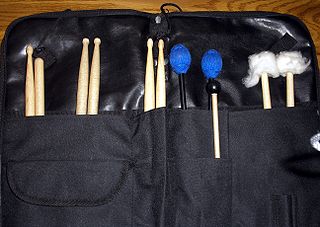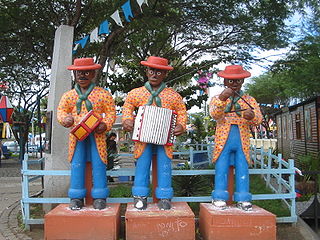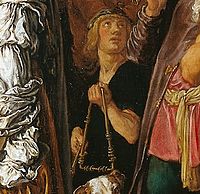
A cymbal is a common percussion instrument. Often used in pairs, cymbals consist of thin, normally round plates of various alloys. The majority of cymbals are of indefinite pitch, although small disc-shaped cymbals based on ancient designs sound a definite note. Cymbals are used in many ensembles ranging from the orchestra, percussion ensembles, jazz bands, heavy metal bands, and marching groups. Drum kits usually incorporate at least a crash, ride, or crash/ride, and a pair of hi-hat cymbals. A player of cymbals is known as a cymbalist.

The drum is a member of the percussion group of musical instruments. In the Hornbostel-Sachs classification system, it is a membranophone. Drums consist of at least one membrane, called a drumhead or drum skin, that is stretched over a shell and struck, either directly with the player's hands, or with a percussion mallet, to produce sound. There is usually a resonant head on the underside of the drum. Other techniques have been used to cause drums to make sound, such as the thumb roll. Drums are the world's oldest and most ubiquitous musical instruments, and the basic design has remained virtually unchanged for thousands of years.

A percussion instrument is a musical instrument that is sounded by being struck or scraped by a beater including attached or enclosed beaters or rattles struck, scraped or rubbed by hand or struck against another similar instrument. Excluding zoomusicological instruments and the human voice, the percussion family is believed to include the oldest musical instruments. In spite of being a very common term to designate instruments, and to relate them to their players, the percussionists, percussion is not a systematic classificatory category of instruments, as described by the scientific field of organology. It is shown below that percussion instruments may belong to the organological classes of idiophone, membranophone, aerophone and chordophone.

The bass drum is a large drum that produces a note of low definite or indefinite pitch. The instrument is typically cylindrical, with the drum's diameter much greater than the drum's depth, with a struck head at both ends of the cylinder. The heads may be made of calfskin or plastic and there is normally a means of adjusting the tension either by threaded taps or by strings. Bass drums are built in a variety of sizes, but size does not dictate the volume produced by the drum. The pitch and the sound can vary much with different sizes, but the size is also chosen based on convenience and aesthetics. Bass drums are percussion instruments and vary in size and are used in several musical genres. Three major types of bass drums can be distinguished.

A clef is a musical symbol used to indicate which notes are represented by the lines and spaces on a musical staff. Placing a clef on a staff assigns a particular pitch to one of the five lines or four spaces, which defines the pitches on the remaining lines and spaces.

In organology, the study of musical instruments, many methods of classifying instruments exist. Most methods are specific to a particular cultural group and were developed to serve that culture's musical needs. Culture-based classification methods sometimes break down when applied outside that culture. For example, a classification based on instrument use may fail when applied to another culture that uses the same instrument differently.

An idiophone is any musical instrument that creates sound primarily by the vibration of the instrument itself, without the use of air flow, strings (chordophones), membranes (membranophones) or electricity (electrophones). It is the first of the four main divisions in the original Hornbostel–Sach system of musical instrument classification. The early classification of Victor-Charles Mahillon called this group of instruments autophones. The most common are struck idiophones, or concussion idiophones, which are made to vibrate by being struck, either directly with a stick or hand or indirectly, with scraping or shaking motions. Various types of bells fall into both categories. A common plucked idiophone is the Jew's harp.

A sistrum is a musical instrument of the percussion family, a form of rattle, used most notably by the ancient Egyptians. It consists of a handle and a U-shaped metal frame, made of brass or bronze and ranging from 30–76 cm (12–30 in) in width. The frame supports sliding metal cross-bars which may hold metal rings. When shaken, the small rings or loops of thin metal on its movable crossbars produce a sound that can vary from a soft clank to a loud jangling. Its name in the ancient Egyptian language was sekhem (sḫm) or sesheshet (sššt) because of the sound it made when it rattled.The ancient Egyptian sistrum had important associations with religious and ritualistic practices concerning various musical and joyful deities.

A percussion mallet or beater is an object used to strike or beat a percussion instrument to produce its sound.

The flexatone or fleximetal is a modern percussion instrument consisting of a small flexible metal sheet suspended in a wire frame ending in a handle. Used in classic cartoons for its glissando effect, its sound is comparable to the musical saw.

The term forró refers to a musical genre, a rhythm, a dance and the event itself where forró music is played and danced. Forró is an important part of the culture of the Northeastern Region of Brazil. It encompasses various dance types as well as a number of different musical genres. Their music genres and dances have gained widespread popularity in all regions of Brazil, especially during the Brazilian June Festivals. Forró has also become increasingly popular all over the world, with a well-established forró scene in Europe.
Orchestral percussion refers to the various percussion instruments used in an orchestral setting. It may also refer to the act of playing such instruments in an orchestral style. Many music schools and conservatories offer training for musicians interested in developing their skills as orchestral percussionists. Typically, an orchestral percussionist does not specialize in one particular instrument. Although there is no exhaustive list of all instruments that an orchestral percussionist must be able to play, there are particular instruments that are frequently used in the orchestral repertoire. This includes timpani, snare drum, bass drum, xylophone, glockenspiel, triangle, and tambourine.
Struck idiophones is one of the categories of idiophones that are found in the Hornbostel-Sachs system of musical instrument classification.

A bell tree, also known as tree bells or Chinese bell tree, is a percussion instrument, consisting of vertically nested inverted metal bowls. The bowls, placed on a vertical rod, are arranged roughly in order of pitch. The number of bowls can vary between approximately 14 and 28. An effective glissando is produced by sliding a triangle beater, a glockenspiel mallet, or a xylophone mallet down the length of the tree. The bells are usually pitched to microtonal intervals and do not represent any formal scale. When a glissando is played, the inexactness of the order of the bowls' pitch is unnoticeable, merely creating a fuller sound.

A flamenco guitar is a guitar similar to a classical guitar, but with thinner tops and less internal bracing. It usually has nylon strings, like the classical guitar, but it generally possesses a livelier, more gritty sound compared to the classical guitar. It is used in toque, the guitar-playing part of the art of flamenco.
An acoustic guitar is a musical instrument in the string family. When a string is plucked, its vibration is transmitted from the bridge, resonating throughout the top of the guitar. It is also transmitted to the side and back of the instrument, resonating through the air in the body, and producing sound from the sound hole. While the original, general term for this stringed instrument is guitar, the retronym 'acoustic guitar' – often used to indicate the steel stringed model – distinguishes it from an electric guitar, which relies on electronic amplification. Typically, a guitar's body is a sound box, of which the top side serves as a sound board that enhances the vibration sounds of the strings. In standard tuning the guitar's six strings are tuned (low to high) E2 A2 D3 G3 B3 E4.

Hand percussion is a percussion instrument that is held in the hand. They can be made from wood, metal or plastic, bottles stops and are usually shaken, scraped, or tapped with fingers or a stick. It includes all instruments that are not drums or pitched percussion instruments such as the marimba or the xylophone.

The nagara or naghara is a drum used in India. There are several types of naghara, which is considered to be the lead instrument in mandir ceremonies and weddings. These are typically two drums, one treble and one bass and are played with sticks.

Music technology is the study or the use of any device, mechanism, machine or tool by a musician or composer to make or perform music; to compose, notate, playback or record songs or pieces; or to analyze or edit music.

Mechanical music technology is the use of any device, mechanism, machine or tool by a musician or composer to make or perform music; to compose, notate, play back or record songs or pieces; or to analyze or edit music. The earliest known applications of technology to music was prehistoric peoples' use of a tool to hand-drill holes in bones to make simple flutes. Ancient Egyptians developed stringed instruments, such as harps, lyres and lutes, which required making thin strings and some type of peg system for adjusting the pitch of the strings. Ancient Egyptians also used wind instruments such as double clarinets and percussion instruments such as cymbals. In Ancient Greece, instruments included the double-reed aulos and the lyre. Numerous instruments are referred to in the Bible, including the horn, pipe, lyre, harp, and bagpipe. During Biblical times, the cornet, flute, horn, organ, pipe, and trumpet were also used. During the Middle Ages, hand-written music notation was developed to write down the notes of religious Plainchant melodies; this notation enabled the Catholic church to disseminate the same chant melodies across its entire empire.






















